| Listing 1 - 10 of 33 | << page >> |
Sort by
|
Book
ISBN: 128286758X 9786612867583 0773577130 9780773577138 9781282867581 0773534563 9780773534568 6612867582 Year: 2009 Publisher: Montreal ; Ithaca : McGill-Queen's University Press,
Abstract | Keywords | Export | Availability | Bookmark
 Loading...
Loading...Choose an application
- Reference Manager
- EndNote
- RefWorks (Direct export to RefWorks)
Why are so many contemporary poets writing elegies? Given a century shaped by two world wars, vast population displacements, and shifting attitudes towards aging and death, is the elegy form adaptable to the changing needs of writers and audiences? In a sceptical age, where can consolation be found? In We Are What We Mourn Priscila Uppal examines why and how the work of mourning has drastically changed in the latter half of the twentieth century, focusing on the strong pattern in contemporary English-Canadian elegy that emphasizes connection rather than separation between the living and the dead. Uppal offers a penetrating reading of Canadian elegies that radically challenges English and American elegy traditions as well as long-standing psychological models for successful mourning. She sets up useful categories for elegy study - parental elegies, elegies for places, and elegies for cultural losses and displacements - and suggests where elegy and mourning studies might be headed post 9/11. The first book on the Canadian poetic elegy, We Are What We Mourn challenges all previous ideas about the purpose of mourning and will intrigue anyone interested in how mourning shapes cultural identity.
Death in literature. --- Grief in literature. --- Mourning customs in literature.
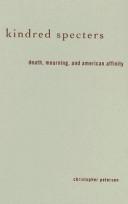
ISBN: 9780816649839 0816649839 9780816649846 0816649847 0816653941 Year: 2007 Publisher: University of Minnesota Press
Abstract | Keywords | Export | Availability | Bookmark
 Loading...
Loading...Choose an application
- Reference Manager
- EndNote
- RefWorks (Direct export to RefWorks)
The refusal to recognize kinship relations among slaves, interracial couples, and same-sex partners is steeped in historical and cultural taboos. In Kindred Specters', Christopher Peterson explores the ways in which non-normative relationships bear the stigma of death that American culture vehemently denies. Probing Derrida's notion of spectrality as well as Orlando Patterson's concept of "social death," Peterson examines how death, mourning, and violence condition all kinship relations. Through Charles Chesnutt's The' Conjure Woman', Peterson lays bare concepts of self-possession and dispossession, freedom and slavery. He reads Toni Morrison's Beloved' against theoretical and historical accounts of ethics, kinship, and violence in order to ask what it means to claim one's kin as property. Using William Faulkner's Absalom, Absalom!' he considers the political and ethical implications of comparing bans on miscegenation and gay marriage. Tracing the connections between kinship and mourning in American literature and culture, Peterson demonstrates how racial, sexual, and gender minorities often resist their social death by adopting patterns of affinity that are strikingly similar to those that govern normative relationships. He concludes that socially dead "others" can be reanimated only if we avow the mortality and mourning that lie at the root of all kinship relations. Christopher Peterson is visiting assistant professor of literature at Claremont McKenna College.
Death in literature. --- Kinship in literature. --- Mourning customs in literature.
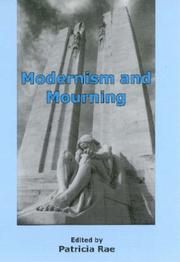
ISBN: 0838756174 9780838756171 Year: 2007 Publisher: Lewisburg Bucknell university press
Abstract | Keywords | Export | Availability | Bookmark
 Loading...
Loading...Choose an application
- Reference Manager
- EndNote
- RefWorks (Direct export to RefWorks)
English literature --- Modernism (Literature) --- Mourning customs in literature. --- American literature --- History and criticism. --- Modernism (Literature). --- Mourning customs in literature --- Crepuscolarismo --- Literary movements --- Postmodernism (Literature) --- History and criticism
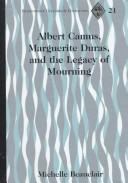
ISBN: 0820430005 Year: 1998 Publisher: New York (N.Y.): Lang
Abstract | Keywords | Export | Availability | Bookmark
 Loading...
Loading...Choose an application
- Reference Manager
- EndNote
- RefWorks (Direct export to RefWorks)
Grief in literature --- Mourning customs in literature --- Camus, Albert, --- Duras, Marguerite --- Criticism and interpretation.
Book
ISBN: 9781849352857 1849352852 1849352844 9781849352840 Year: 2017 Publisher: Chico, CA : AK Press,
Abstract | Keywords | Export | Availability | Bookmark
 Loading...
Loading...Choose an application
- Reference Manager
- EndNote
- RefWorks (Direct export to RefWorks)
"This intimate, moving, and timely collection of essays points the way to a world in which the burden of grief is shared, and pain is reconfigured into a powerful force for social change and collective healing." Astra Taylor, author The People's Platform "A primary message here is that from tears comes the resolve for the struggle ahead." Ron Jacobs, author of Daydream Sunset "Rebellious Mourning uncovers the destruction of life that capitalist development leaves in its trail. But it is also witness to the power of grief as a catalyst to collective resistance." Silvia Federici, author of Caliban and the Witch We can bear almost anything when it is worked through collectively. Grief is generally thought of as something personal and insular, but when we publicly share loss and pain, we lessen the power of the forces that debilitate us, while at the same time building the humane social practices that alleviate suffering and improve quality of life for everyone. Addressing tragedies from Fukushima to Palestine, incarceration to eviction, AIDS crises to border crossings, and racism to rape, the intimate yet tenacious writing in this volume shows that mourning can pry open spaces of contestation and reconstruction, empathy and solidarity.
Grief. --- Loss (Psychology) --- American literature --- Mourning customs in literature. --- Grief in literature. --- Psychology --- Mourning --- Sorrow --- Bereavement --- Emotions
Book
Year: 1968 Publisher: Nendeln/Liechtenstein : Kraus Reprint,
Abstract | Keywords | Export | Availability | Bookmark
 Loading...
Loading...Choose an application
- Reference Manager
- EndNote
- RefWorks (Direct export to RefWorks)
Russian poetry --- Belarusian poetry --- Ukrainian poetry --- Laments --- Death in literature. --- Mourning customs in literature. --- History and criticism. --- History and criticism
Book
ISBN: 1684481953 9781684481958 9781684481927 9781684481910 1684481910 1684481929 Year: 2020 Publisher: Lewisberg, Pennsylvania : Bucknell University Press,
Abstract | Keywords | Export | Availability | Bookmark
 Loading...
Loading...Choose an application
- Reference Manager
- EndNote
- RefWorks (Direct export to RefWorks)
Narrative Mourning explores death and its relics as they appear within the confines of the eighteenth-century British novel. It argues that the cultural disappearance of the dead/dying body and the introduction of consciousness as humanity's newfound soul found expression in fictional representations of the relic (object) or relict (person). In the six novels examined in this monograph--Samuel Richardson's Clarissa and Sir Charles Grandison; Sarah Fielding's David Simple and Volume the Last; Henry Mackenzie's The Man of Feeling; and Ann Radcliffe's The Mysteries of Udolpho--the appearance of the relic/relict signals narrative mourning and expresses (often obliquely) changing cultural attitudes toward the dead. Published by Bucknell University Press. Distributed worldwide by Rutgers University Press.
Manners and customs --- Mourning customs in literature. --- Relics in literature. --- Death in literature. --- English fiction --- History --- History and criticism.
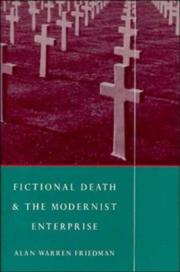
ISBN: 0521442613 Year: 1995 Publisher: Cambridge : Cambridge university press,
Abstract | Keywords | Export | Availability | Bookmark
 Loading...
Loading...Choose an application
- Reference Manager
- EndNote
- RefWorks (Direct export to RefWorks)

ISBN: 0521626331 Year: 1999 Publisher: New York Cambridge Melbourne Cambridge University Press
Abstract | Keywords | Export | Availability | Bookmark
 Loading...
Loading...Choose an application
- Reference Manager
- EndNote
- RefWorks (Direct export to RefWorks)
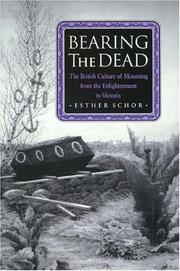
ISBN: 069103396X 9786612752063 1400821487 1282752065 1400813336 9781400813339 9780691033969 1400807131 140080714X 9781400807147 9781282752061 9781400821488 Year: 1994 Publisher: Princeton, N.J. : Princeton University Press,
Abstract | Keywords | Export | Availability | Bookmark
 Loading...
Loading...Choose an application
- Reference Manager
- EndNote
- RefWorks (Direct export to RefWorks)
Esther Schor tells us about the persistence of the dead, about why they still matter long after we emerge from grief and accept our loss. Mourning as a cultural phenomenon has become opaque to us in the twentieth century, Schor argues. This book is an effort to recover the culture of mourning that thrived in English society from the Enlightenment through the Romantic Age, and to recapture its meaning. Mourning appears here as the social diffusion of grief through sympathy, as a force that constitutes communities and helps us to conceptualize history. In the textual and social practices of the British Enlightenment and its early nineteenth-century heirs, Schor uncovers the ways in which mourning mediated between received ideas of virtue, both classical and Christian, and a burgeoning, property-based commercial society. The circulation of sympathies maps the means by which both valued things and values themselves are distributed within a culture. Delving into philosophy, politics, economics, and social history as well as literary texts, Schor traces a shift in the British discourse of mourning in the wake of the French Revolution: What begins as a way to effect a moral consensus in society turns into a means of conceiving and bringing forth history.
Death in literature --- English literature --- -Grief in literature --- Literature and history --- -Mourning customs --- -Mourning customs in literature --- -British literature --- Inklings (Group of writers) --- Nonsense Club (Group of writers) --- Order of the Fancy (Group of writers) --- Manners and customs --- Rites and ceremonies --- Funeral rites and ceremonies --- History and literature --- History and poetry --- Poetry and history --- History --- History and criticism --- -History --- -History and criticism --- Thematology --- anno 1800-1899 --- anno 1700-1799 --- Death in literature. --- Grief in literature. --- Mourning customs in literature. --- Mourning customs --- History and criticism. --- Grief in literature --- Mourning customs in literature
| Listing 1 - 10 of 33 | << page >> |
Sort by
|

 Search
Search Feedback
Feedback About UniCat
About UniCat  Help
Help News
News